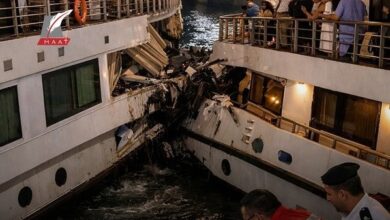Visual Arts and Restoration, currently on display at the Italian Institute of Culture, is a complex exhibition that chronicles the career of the renowned Italian architect and director of the Italian-Egyptian Center for Restoration and Archeology, Giuseppe Fanfoni. Combining architecture and environment, but also painting, sculpture, restoration and city planning, the fascinating exhibition takes philosophy of religion as its main theme.
The photographs on display show the prolific activities of Fanfoni, who has been working as an expert of restoration at the University of Rome, as a Professor of Design at the Professional School of the Arts in Rome, and as a Professor of Methodology and Restoration Technique at Cairo University.
The works presented span from his early years, even before his artistic studies, to the more recent restoration of the Sama’Khana (Hall of Listening), a monument at the feet of the Citadel also known as the Sufi Theater, which has recently been opened to the public after a restoration that began in 1979.
Visual Arts and Restoration is a demanding exhibition for laypersons, but inspiring to anyone interested in architecture and restoration.
Fanfoni explained, “I preferred setting up an only-photographs exhibition because the transportation of the original works would have been too difficult.” As a consequence, the spectator can only imagine the life-size pieces in methacrylate-neon, polyurethane, ceramic and clay. But, as the artist underlined, “The technique is only an instrument, even though the modern society is concerned with that. The content is important, while the technique varies according to the content.”
Fanfoni’s artistic philosophy is expressed in three main projects: the war memorial in Sicily’s Barcellona Pozzo Gotto square, Cairo’s Sama’Khana, and the Sicilian Villa Finocchiaro.
The Barcellona monument rises directly from the asphalt in massive blocks forming broken lines, short at first, then looming above the crowd. “The memorial represents war as deviation from human activity, which is by nature prone to peaceful coexistence,” said Fanfoni. The steps make movement difficult by becoming increasingly higher in the internal structure, a sign of the “mental deviations from human behavior that could be changed. Unfortunately, professors often teach wars and the institutionalization of religions while taking no notice of their origins. This is a mistake because it’s in the origin of a religion as well as in art that you can find the real knowledge.”
A church in the distance symbolizes the origin of religion, not its institutionalization. “The origin of religion is important, not the power; Christ not the Christians; Islam not Islamism. Religion should be seen as salvation not as power,” said Fanfoni.
The Sama’Khana, dating from around 1800, is significant for its geometrical proportion. It has been restored according to the final adjustments made in the mid-1800s, and according to the symbols of the Sama, the performance of the Mevlevi.
“The first time I entered the Sama’Khana, I wasn’t surprised by the beauty of the place. On the contrary, I noticed a pillar pressing on a shelf, and I perceived the pain of the pillar, and the stimulus to help it,” Fanfoni explained.
The restoration followed the worksite method that aims at teaching while working. “This is a way to experience the object beyond the notion, avoiding it becoming speculation and commodification of culture. The conservation shouldn’t be appropriation of the object but rather conservation of contents, which we, as modern people, should admit to not completely get,” Fanfoni added.
In the exhibition, Fanfoni's philosophy is lastly represented by Villa Finocchiaro, an “example of organic architecture, because lines follow the mountain shape. In nature, straight lines don’t exist; they are just an abstraction. The leaf, as well as anything else in nature, can’t be perfectly straight; we’re living in a world of abstraction, which is mad.”
Visual Arts and Restoration is on display at the Italian Institute of Culture from 20 October till 20 November 2010
3 al-Sheikh al-Marsafi Street,
Zamalek, Cairo
The gallery is open from 10AM to 6PM from Sunday to Thursday




